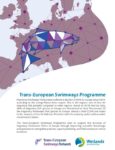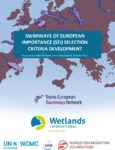Freshwater fish in Europe are currently facing many threats and pressures, greatly affecting their ability to survive and reproduce. According to the European Red List of Freshwater Fishes, 39% of the freshwater fish species in the EU are threatened and a further 4% are near threatened. According to the EEA’s State of Nature in the EU report, about 90% of the fish species listed in Annex 2 of the EU Habitats Directive have a bad or poor conservation status. Migratory freshwater fish species are particularly at risk and their populations have suffered a 93% decline in Europe since 1970, according to the Living Planet Index report, which is the highest rate globally.
Some of the main causes of the decline of freshwater fish species include modifications of hydrological flows, physical alterations of waterbodies, and hydropower installations. These factors are very widespread in Europe, with more than 1 million barriers, such as dams and dikes, present in European rivers. Migratory fish are especially sensitive to such barriers, which block their pathways, disrupting the connectivity between habitats needed throughout their life cycle.
Trans-European Swimways Network (TEN-S)
To address these issues, we are working to raise the profile of fish migration as a concern, with the aim of connecting fish, rivers, and people across borders in Europe. We are doing this by bringing together stakeholders – local and national NGOs, researchers, and governments – within the Trans-European Swimways Network (TEN-S). This will foster international cooperation, improve scientific knowledge and guidance, support strengthened EU policies, and accelerate their implementation. Ultimately, we envision this will improve the conservation of freshwater fish and rivers across Europe.
Why the term ‘swimways’?
This is based on the flyways approach used over the past 50 years for the collaborative conservation of migratory birds across their entire range, from their breeding grounds to wintering areas. The Swimways movement is inspired by the powerful instruments and successes of the flyways approach, such as the Ramsar Convention on Wetlands and the Agreement on the Conservation of African-Eurasian Migratory Waterbirds. It will make use of the lessons learnt from the flyways approach, focusing instead on freshwater fish, and their underwater movements, which are even more dependent on uninterrupted connectivity within their habitats.
Why Trans-European?
While local conservation initiatives for certain species and river restoration currently exist, there is a need for a more joined-up approach for the conservation of migratory fish across all of Europe. This is especially the case for long-distance migratory fish whose paths can cross multiple countries. The name also references the Trans-European Transport Network, a major EU infrastructure programme responsible for disrupting swimways through the development of waterways, with the associated infrastructure and river management.
The European Swimways Programme is the regional implementation of the recent Global Swimways work. The Global Swimways Programme is the first major proposal of the term Swimways and has initiated discussion on the topic while providing background and proposing metrics for identifying and classifying swimways. A paper presenting the work and thinking of the Global Swimways Programme can be found here. They also created a global online swimways map as a demonstration of the idea, using fully assessed IUCN species data plus layers for threats (dam databases) and species layers (species richness, endemic species, threatened species).
Trans-European Swimways Programme
In 2022, we worked with TEN-S to develop the first Trans-European Swimways Programme. The programme examines the current status of migratory freshwater fish in Europe, the threats they face, and ongoing conservation efforts, then uses these elements to build a framework for action. We will seek to put this framework for action into practice over the coming years. See the full programme report below. Trans-European Swimways Programme

Discover our illustrated leaflet to have a brief overview of our work. The leaflet can be downloaded below.

Trans-European Swimways Programme Leaflet
downloadFinally, we invite you to read through our latest report on the development of biological criteria to identify Swimways of European Importance (SEIs) here : SEI - Report on the selection criteria development
Our Goals
- Raise public and political awareness about migratory freshwater fish and habitat connectivity in Europe.
- Contribute to the ongoing discussions on the EU Nature Restoration Law and other EU legislation by advocating for stronger protection of connectivity in European rivers and consideration of migratory fish.
- Connect diverse stakeholders from across the continent to create a stronger voice for protecting migratory freshwater fish and sharing best practices.
- Stem the decline of migratory freshwater fish and help them to recover their population and range.
Get Involved
We welcome any organisations or individuals with an interest in migratory freshwater fish conservation to join the Trans-European Swimways Network (TEN-S).
To join TEN-S, please write to the Swimways Coordinator, Heather Bond, at [email protected].
We look forward to your participation!




